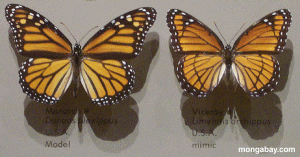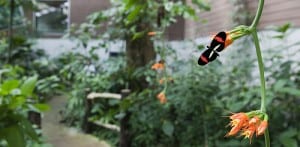Tripatini
the world's smartest travel social network
Costa Rica butterflies share evolution strategies for survival
In the case of butterflies, it pays to look like your neighbor.
New information about long-winged butterflies in Costa Rica is showing how the importance of “mimicry” and the![]() butterflies’ natural promiscuity has led to interbreeding and the creation of new species that look very much alike, according to a study led by University of Chicago evolutionary biologist, Marcus R....
butterflies’ natural promiscuity has led to interbreeding and the creation of new species that look very much alike, according to a study led by University of Chicago evolutionary biologist, Marcus R....
“In evolutionary biology, mimicry is the similarity of one species to another which protects one or both.This similarity can be in appearance, behavior, sound, scent and location, with the mimics found in similar places to their models,” notes Wikipedia.
Mimicry, or looking like another, is important to butterflies to avoid being a tasty snack for birds and other predators. If a tasty or non-venomous butterfly is confused with a bad-tasting or toxic butterfly, both species will go unmolested and be more likely to survive.
 Take, for example, the Viceroy butterfly (Limenitis archippus) which mimics the Monarch Butterfly (Danaus plexippus) in shared orange and black coloration patterns. While the Viceroy butterfly isn’t incredibly appetizing to birds, it is not highly toxic like the Monarch; yet because they look alike, predators tend to leave both alone.
Take, for example, the Viceroy butterfly (Limenitis archippus) which mimics the Monarch Butterfly (Danaus plexippus) in shared orange and black coloration patterns. While the Viceroy butterfly isn’t incredibly appetizing to birds, it is not highly toxic like the Monarch; yet because they look alike, predators tend to leave both alone.
The long-winged Heliconius butterflies are the species in the study whipping up interest. The butterflies, including one known as the “Costa Rican postman,” have bright orange markings on their wings and are toxic. Promiscuous habits have led to the creation of up to 45 new species from the butterflies’ interbreeding, scientists report. The interesting thing the geneticists have discovered is that all of the species resemble one another (Mullerian mimicry) with slight differences, which has led to shared survival tactics by baffling predators into avoiding a range of wing patterns.
![]() Approximately 17,500 species of butterflies exist in the world, according to the Smithsonian Institute. Costa Rica is home to about 1,251 species of butterflies and at least 8,000 species of moths, cites Wikipedia.
Approximately 17,500 species of butterflies exist in the world, according to the Smithsonian Institute. Costa Rica is home to about 1,251 species of butterflies and at least 8,000 species of moths, cites Wikipedia.
The Butterfly Garden at Veragua Rainforest Research & Adventure, in Costa Rica’s Caribbean rainforest, is inhabited by some of the most colorful butterflies in the world, including the noteworthy Heliconius butterflies. A tour at the 1,300 hectare (3,212 acre) biology research center and adventure park lets you walk through an immense live butterfly garden, plus visit a research lab where staff scientists study the behavior and lifestyle of these vivid flying insects.
 Veragua Rainforest Research & Adventure is located in the Talamanca Mountain Range about an hour inland from Costa Rica’s Caribbean port of Limón. Veragua Rainforest is an excellent one-day tour in the Costa Rica rainforest. Attractions include wildlife exhibits and science labs, an aerial tram, canopy zipline tour, rainforest hiking trails, a river with waterfalls, and a restaurant, café and souvenir shop.
Veragua Rainforest Research & Adventure is located in the Talamanca Mountain Range about an hour inland from Costa Rica’s Caribbean port of Limón. Veragua Rainforest is an excellent one-day tour in the Costa Rica rainforest. Attractions include wildlife exhibits and science labs, an aerial tram, canopy zipline tour, rainforest hiking trails, a river with waterfalls, and a restaurant, café and souvenir shop.
Article by Shannon Farley
Videos
Groups
-
India
173 members
-
Tour Operators
873 members
-
Ireland
93 members
-
South Dakota
17 members
-
Azerbaijan
17 members
-
Shopping the World
55 members
-
Tech for Travel/Hospital…
87 members
-
Andorra
26 members
-
Online Corner
75 members
-
Minnesota
22 members
-
Backpackers & Hostels
84 members
-
Portugal
60 members
-
Turks and Caicos
26 members
-
Agritourism/Farmstays
72 members
-
Zambia
21 members
© 2025 Created by EnLinea Media.
Powered by
![]()
Badges | Report an Issue | Privacy Policy | Terms of Service
You need to be a member of Tripatini to add comments!
Join Tripatini